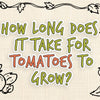How Much Sun Do Tomatoes Need? A Detailed Guide
Tomatoes require a minimum of 6 to 8 hours of sunlight every day (link).
Why so much? This is to keep up with the energy requirements of the tomato plant, especially during the fruiting stage. The plant needs to keep the photosynthesis process on a maximum, and this process is driven by sunlight. In this article, we are going to take a look at some of the ways you can improve in growing tomatoes by taking full advantage of the sun.
Not Much Time? Skip To What You'd Like To Learn...
-
Considerations For Deciding On The Amount of Sunlight for Your Tomato Plants
-
Sunlight Requirements During Various Stages of Growth
-
Tomato Types and Their Sunlight Requirements
-
Quick FAQ’s
Considerations For Deciding On The Amount of Sunlight for Your Tomato Plants
Sunlight has a significant downside in that its intensity fluctuates during the day depending on the position of the sun as well as other weather-related factors such as cloud cover. The heat that accompanies sunlight is actually the most significant concern and as such its recommended to identify a way to maximize your plant’s exposure to sunlight while minimizing the harmful heat effects (link).
For starters sunlight can be categorized according to the time of the day whereby we have the following categories:
Morning Sunlight
Morning light has the highest ultraviolet intensity. Just like other green plants tomatoes absorb these rays in the chlorophyll molecules and use the energy for photosynthesis.
To maximize this process remove any obstacles that might be blocking your tomato plants from accessing morning sunlight, if they are potted you can move them to the east-facing side.
The morning sunlight is also accompanied by less heat which is suitable for your plants allowing them to take full advantage of the conditions and produce the much-required energy. Morning sunlight also helps to evaporate the dew that accumulates on the leaves overnight and can lead to fungal infections in tomato plants.
Midday Sunlight
During this stage, the mercury rises to almost damaging levels, especially when experiencing harsh summer heat waves.
While tomatoes can withstand some of these higher temperatures, it's recommended to put up some layer of protection in the form of shading to prevent damage to the fruits as well as wilting. This can be done by setting up a shade cloth structure over your plants.
Most of the shade cloths are rated by percentage, e.g. a 50% shade cloth material will filter out at least 50% of the sunlight and at least 25% of the solar heat. Shading your plants during such extreme weather also reduces bloom fall which is associated with dry conditions that restrict pollination.
Afternoon Sunlight
The afternoon sun offers the much-needed ultraviolet intensity without the extra high heat.
Your tomato garden should, therefore, offer access to afternoon sunlight which is easily achieved by removing any shade on the west facing side. This allows the tomato plants to maximize photosynthesis once more just like during the morning sun. In fact, a combination of the two is best in order to achieve the recommended sunlight.
Sunlight Requirements During Various Stages of Growth

Vegetative Growth Stage
Approximate hours of sun per day: 6 hours
This stage occurs after you have transplanted the seedling from the nursery to its final growing space (garden or pots). During this stage, the plant undergoes vegetative growth whereby the vine and leaves double in size every 2 weeks.
Photosynthesis is required to be kept at a maximum so the plant should have all the sunshine exposure possible. The plant usually gets quite leafy (directly attributed to the amount of nitrogen applied) and will, therefore, require more water as well as other nutrients during this stage.
Flowering Stage
Approximate hours of sun per day: 7 hours
This is probably the second most delicate stage (only superseded by transplanting stage) and requires controlled exposure to sunlight. While the main plant will need as much sunlight to keep up with the additional energy requirements from the flower formation process those little blossoms are also susceptible to dry conditions. It is, therefore, recommended to use a shade cloth with the east and west sides fully uncovered.
Having such a shade structure ensures maximum morning and afternoon sunshine penetration for optimum ultraviolet rays absorption. The shading also protects the flowers from direct heat which leads to increased bloom fall. However, the shade is bound to reduce the pollination rate, so it's recommended to apply a bit of hand pollination.
Fruiting Stage
Approximate hours of sun per day: 10 hours
Young tomato fruits can get sunscald especially during their growth stage. If your area is experiencing clear skies, high light radiation or high temperatures, then it's recommended to provide shade for your tomato fruits.
As the fruits grow the plant’s energy requirements increase, this should be resolved by ensuring that the plants get at least 10 hours of sunlight with the majority of it being during the morning and late afternoons.
Ripening Stage
Approximate hours of sun per day: 0 hours
As the tomatoes mature, you might wonder what role does sunlight play in the ripening process? Well, none at all, the process is instead controlled by ethylene hormone. Tomatoes ripen faster in darkness so, you can pick the mature fruits and store them in your pantry to ripen naturally.
(link)
Interested In Growing Tomatoes?

At grow your pantry we have developed the perfect tomato cage. It's strong, multitiered, supports growth through all stages, strong and sturdy.
[Check Out The Latest Price Here]
Tomato Types and Their Sunlight Requirements

Tomatoes can be grouped into two broad categories based on their fruiting cycles.
Determinate Variety - Determinate varieties have a single fruiting cycle and form flowers at the end of the stocks forming fruits which generally mature around the same time. After this single harvest, the plant shrivels and dies.
This variety is much easier to manage especially in terms of sunlight management; their canopy usually protects the underlying fruits from direct sunshine exposure, and therefore they don’t require much intervention. The fact that the fruits all grow around the same time means that the number of days that the fruits are exposed to the scorching sun is greatly diminished.
Intermediate Variety - The indeterminate varieties, on the other hand, is characterized by long vines along which the flowers form which allows for growing tomatoes throughout the season. As a result, they are favored by local market farmers and home growers.
The vines have to be trained, and this introduces some complexity in terms of sunshine exposure to ensure maximum sunshine penetration it's advisable to space the plants adequately. The upward growing vines, however, do offer a significant advantage in that the fruits are well sheltered within the canopy of leaves from overhead sunshine.
(link)
The two categories can be further broken down into the following varieties:
Beefsteak Tomatoes
Approximate hours of sunlight per day: 12 hours
These kidney-bean shaped tomatoes are famous for their thin skin making them a favorite in sandwich preparation. Beefsteak tomatoes love sunny conditions and are capable of withstanding the hot summer climate. You should plant this variety in an open kitchen garden for maximum sunlight exposure (link).
Plum Tomatoes
Approximate hours of sunlight per day: 8 hours
These are bred with lower water and higher solids content which makes the perfect sauce (link).
Cherry Tomatoes
Approximate hours of sunlight per day: 8 hours
These are small round tomatoes with a sweet flavor. This variety is rather hardy and grows well in the wild although with reduced fruit size. This variety can grow even in the harsh summer heat without the need for any shading. Grow these in containers away from shadows and move them around if they get shaded (link).
Pear Tomatoes
Approximate hours of sunlight per day: 8 hours
Just as the name suggests, this tomato has a pear-shaped fruit. Pear tomatoes are indeterminate and have a more extended season compared to other varieties. Making it suitable for warmer climates and full sun exposure (link).
Campari Tomatoes
Approximate hours of sunlight per day: 6 hours
These sweet juicy tomatoes are characterized by low acidity and lack of mealiness. Campari tomatoes are smaller than plum tomatoes but bigger than cherry tomatoes. This variety requires protection from overhead sunshine which can easily scald the fruits (link).
Quick FAQ’s

Can tomatoes grow in the shade?
Yes. Tomatoes can grow in the shade. However, this reduced exposure to sunlight leads to reduced productivity due to the lower levels of energy production via photosynthesis.
Can they get too much sun?
Sometimes. While tomatoes are adapted for tropic environments too much exposure to the sun can have detrimental effects on the plant especially the flowers and fruits. However, there is some drought resistant varieties that have been developed through genetic engineering.
Can they be planted in full sunlight?
Yes. Tomatoes can be planted in full sunlight and will grow well as long as the soil is kept moist. Remember to maintain a proper watering schedule to avoid cracked fruits.
Other Articles You'll Love...
15 Tips For Growing Tomatoes
What Causes Tomato Leaves To Curl?
How Much Sun Do Tomatoes Need?
Why Are My Tomatoes Not Turning Red?
How Far Apart To Plant Tomatoes
Why Are My Tomatoes Splitting?
-
Posted in
tomatoes








Hello I wNt to ask you that I have tomato plant in container is there need to transfer it to garden or it gives good tomatoes